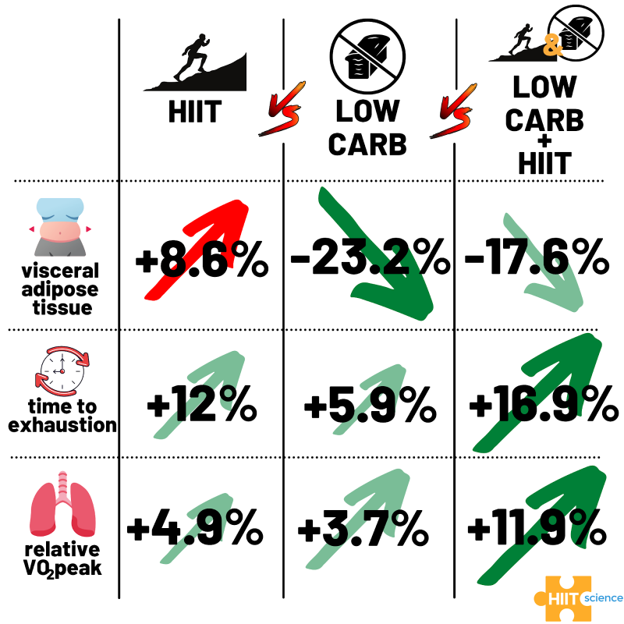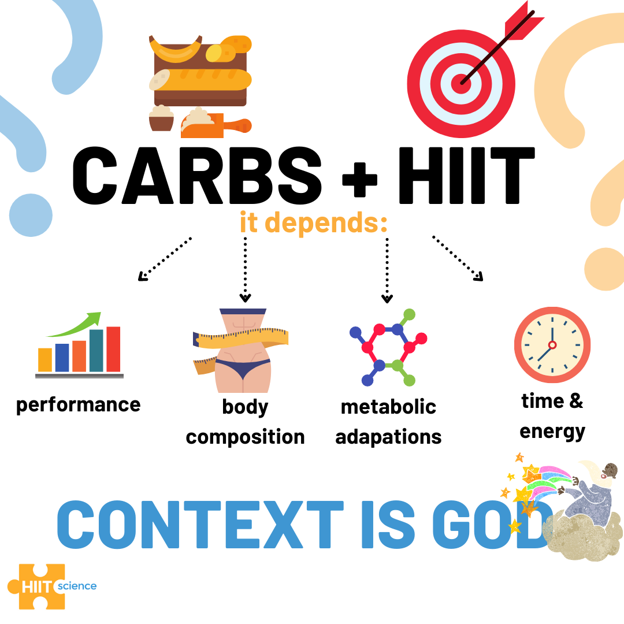Background
One of the first posts we released on HIIT Science, by Martin, was in 2018 and titled Content is King, but Context is God. It’s a principle we always go back to time and time again. In this post, more than 3 years later, we show yet another example from a different but related field — nutrition. Now many of our followers will be aware that yours truly tends to display bias in the direction of a lower carbohydrate approach to diet, health and nutrition. While such a generalization may be true, my viewpoint and practice has shifted over the years to a more balanced and periodized approach using natural whole food sources of all macronutrients. Each macronutrient emphasis has a time and place — and it relates to the context. This aligns with our balanced presentation of HIIT Science blog posts revealing the advantages of both a low carbohydrate and higher carbohydrate approach under different situations, including monitoring recommendations to gain insight into individual responses. Once again, as Martin reminds us, it would appear that context is God in the area of diet and nutrition as well. In this post, and with the context that this time of year brings with various resolutions forefront of mind — how does science inform us on strategy when fat loss is the goal? Imagine you’re a trainer and have a client in front of you with the goal of losing body fat (and has body fat in excess). What’s the more effective approach for this individual? High-intensity interval training (HIIT), a focus on lowering refined carbohydrates and processed food from the diet, or both? For this post, we pull on newly released data from our Frontiers in Nutrition study, titled “Effects of a very low-carbohydrate high-fat (VLCHF) diet and high-intensity interval training on visceral fat deposition and cardiorespiratory fitness in overfat individuals: A randomized controlled clinical trial”.What did we do?
The study included 91 men and women aged 20-59 randomly allocated to the HIIT, VLCHF, VLCHF+HIIT, or control groups for 12 weeks. Body composition and cardiorespiratory fitness were analyzed before the experimental period and after 4, 8, and 12 weeks. Dual-energy X-ray absorptiometry (DXA) and anthropological measures (waist-to-hip, waist-to-height) demonstrated the overweight/obese/overfat conditions. A graded exercise test to volitional exhaustion on a treadmill was used for the cardiorespiratory fitness and exercise performance assessments.
Figure 1. Schematic representation of the study design and HIIT protocol.
What did we find?
In fact, the answer to our question surprised us from the prevailing calorie-counting perspective. While HIIT on a normal diet improved fitness, it didn’t do much from a body composition standpoint over 12 weeks, at least in individuals that suffer from overfat (defined as having excess body fat that impairs health and fitness; ultimately malnourished). But a well-formulated, very low carbohydrate high fat (VLCHF) diet with a focus on natural whole foods, either in isolation or with HIIT, induced a significant reduction in visceral adipose tissue (belly fat) mass and other body composition variables. In this randomized controlled parallel-group study, the significant belly fat decrease in the VLCHF group was revealed after only 4 weeks and continued after 12 weeks. The absolute belly fat mass (g) was reduced by 23.2 % in the VLCHF group, and by 17.6% in the VLCHF+HIIT group. HIIT alone did not cause a substantial belly fat decrease, nor did it show any significant changes in other body composition variables compared to the control group. When HIIT was combined with the VLCHF diet, no extra belly fat changes were revealed either. HIIT alone, and in combination with the VLCHF diet, did substantially improve exercise performance.
Figure 2. Summary of the main findings.
Practical recommendations
The short and sweet message was as follows: Use HIIT to hit your physiological and physical performance targets. Use carbs appropriately to help with HIIT quality. But if body composition and health are the goals, make sure you have your focus on top of your diet and health factors. That’s why study author Phil Maffetone wrote an entire chapter and course on the topic for us. No matter how hard we may try, we simply can’t outrun a bad diet — even with HIIT. So if your New Year’s resolution involves shedding body fat, and your context involves a situation where you have excess body fat to lose, take a good look at your food choices. Our most popular single course by Dr Maffetone is a great place to start.






